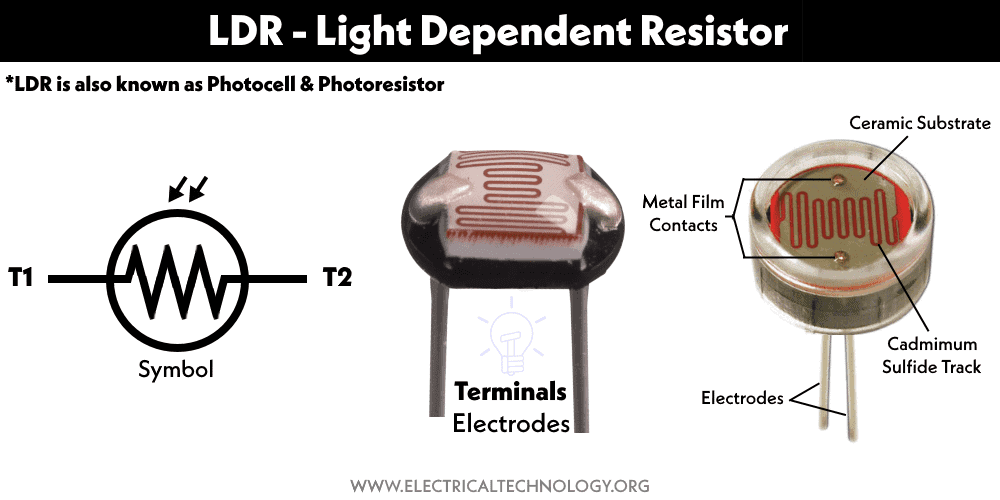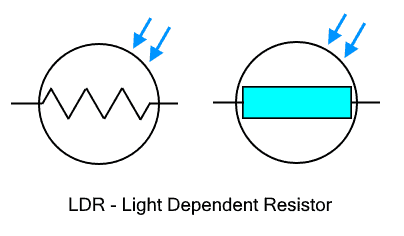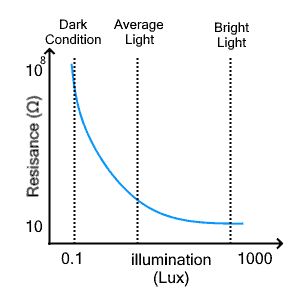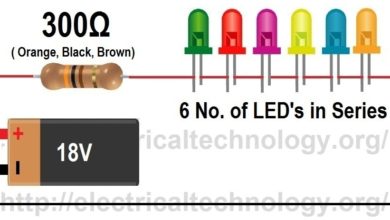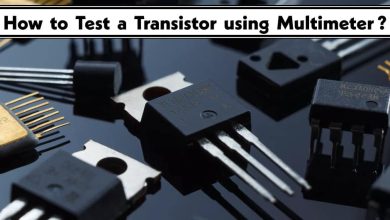What is LDR – Light Dependent Resistor? Construction, Working, Types & Applications
LDR – Light Dependent Resistor, Construction, Working, Types, Advantages, Disadvantages and Applications
There are different types of sensors being used in electrical circuits and they are used to sense different physical quantifies. One such sensor is a light sensor or photo-sensors. They are sensitive to light energy or photons i.e. their electrical characteristics change with the intensity of light. These devices are used to automatically operate outdoor and street lights as well as indoor appliances without the need for any human involvement. These switches operate accordingly with the daylight and reduce the wastage of power. One such switch is LDR which of commonly used in street lights.
What is LDR?
LDR (Light dependent resistor) also known as photocell, photoresistor or Photo Conductive Cell is a light-sensitive resistor whose resistance varies with the intensity of light. It is a type of variable resistor whose resistance varies with the light. Its resistance varies inversely with the change in light intensity i.e. its resistance increases with a decrease in light intensity and decreases with an increase in light intensity.
It is a type of photosensor that works on the principle of photoconductivity. Its electrical conductivity changes with the intensity of the falling light. Its resistance also depends on the frequency and wavelength of the incident light. Although its sensitivity depends on the design and Semiconductor material of the device.
It is used in light sensing circuit that operates based on light and dark conditions such as street lights, solar panels, solar tracker, etc.
Symbol of LDR
The symbol of LDR resembles both resistor and photodiode. The arrows pointing toward the resistor represent the light rays as in photodiode while the rest represent the resistor as shown in the figure below.
Both of the given symbols represent LDR or photoresistor having two terminals.
Related Posts:
- Resistor and Types of Resistors – Fixed, Variable, Linear and Non-Linear
- What is a Sensor? Different Types of Sensors with Applications
Construction of LDR
An LDR is made of an N-type semiconductor material that is sensitive to light and possesses less or no free electrons in no light conductions such as cadmium selenide CdSe or cadmium sulfide CdS. It has very high resistance in the range of mega Ohms under no light conditions. A strip of photoconductive material is placed on top of an insulating substrate in a zigzag pattern to acquire desired resistance and power ratings. Ohmic contacts are made on either side of the strip to form the terminals. The resistance of the ohmic contacts is designed to be as low as possible so that the resistance of LDR only varies with the incident light.
The whole structure is encapsulated inside a transparent resin that protects the photoconductive material from contamination and also allows light through it.
When constructing LDR it is necessary to select a semiconductor material that has excellent light sensitivity and it can handle the current. There are different materials used in the construction of LDR such as CdSe, CdS, CdTe, InSb, InP, PbS, PbSe, Ge, Is, and GaAs. Different materials show different sensitivity depending on the light wavelength. It means these materials show high sensitivity to specific color light.
Due to harmful effects on the environment, the use of cadmium and lead is discouraged globally.
Working of LDR
LDR works on the principle of photoconductivity. According to photoconductivity the conductivity of a material is increased when the intensity of incident light is increased. There are certain semiconductor materials that exhibit such property known as photoconductive material.
There is an energy band gap between the valance band and the conduction band of the semiconductor material. The electrons residing in the valance band cannot participate in the conduction unless energy equal to the amount of the band gap energy is provided. The incident light containing photons had enough energy to excite electrons into the conduction band. The number of electrons passing into the conduction band depends on the amount of light energy.
Since these electrons contribute to the current flow, the resistance of the material decreases. Therefore increasing the intensity of light increases the number of free electrons and decreases the resistance of the LDR.
Related Post:
Types of LDR
The LDR can be classified based on its photoconductive semiconductor material doping and based on its spectral characteristics.
Based on Semiconductor
The material used can be either intrinsic or extrinsic. Therefore LDR can be further classified into two types
Intrinsic LDR
Such LDR is made of intrinsic semiconductor material. Intrinsic semiconductors are in their pure form without any doping. The number of electrons and holes is the same in such material. By applying energy to the electrons, they jump from the valance band into the conduction band. Thus allowing the flow of current through it.
Since in a normal state, there are no free electrons, the conductivity of intrinsic material is low and requires a large amount of light energy to conduct current.
Extrinsic LDR
Such LDR is made of extrinsic semiconductor material. An extrinsic semiconductor is made from an intrinsic semiconductor by including impurities in it called doping. The number of free electrons or holes is increased by including pentavalent impurities (for increasing electrons forming N-type) or trivalent impurities (for increasing holes forming P-type) in the semiconductor material.
LDR uses an N-type semiconductor. The advantage of using extrinsic material is that it has free electrons that form another band over the existing valance band. it requires less energy to jump into the conduction band. Thus extrinsic LDRs have increased sensitivity to light.
Based on Linearity
LDR can be classified into linear and nonlinear.
Linear LDR
The resistance of linear LDR varies linearly with the change in light intensity. The photodiode is sometimes used as linear LDR due to its linear characteristics.
Nonlinear LDR
Such LDR has a non-linear relationship between its resistance and the incident light intensity. Such as CdS, CdSe LDR.
Based on Spectral Characteristics
LDR can be classified based on its sensitivity to a specific light spectrum.
Ultraviolet LDR
Such LDRs are more sensitive to ultraviolet light detection whose wavelength is below 400 nm. CdS and CdSe are best material for UV detection.
Infrared LDR
Such LDR is used for sensing infrared light as they are more sensitive to light having a wavelength above 700 nm and below 1mm. Lead telluride PbTe and indium antimonide InSb are the main material used for its production. It is used in various infrared applications in national defense and scientific research etc.
Visible Light LDR
These are the more common LDR used in daily life light-based applications used to detect visible light.
Related Posts:
- LED – Light Emitting Diode: Construction, Working, Types & Applications
- Photodiode: Types, Construction, Operation, & Applications
Characteristics of LDR
There are certain characteristics of LDR that determines its performance.
Photocurrent and Bright Resistance
The photocurrent is the current flowing through the LDR with the application of voltage when there is light. And the resistance which is the ratio between applied voltage and the photocurrent is called bright Resistance. The bright resistance is denoted by “100lux”.
Dark Current and Dark Resistance
Dark current is the current flowing through LDR with the application of voltage when there is no light. And the resistance is called dark resistance denoted by “0lux”
Max Power Dissipation
The maximum power the LDR dissipates operating in a given range of temperature. LDR is temperature sensitive therefore it is mostly given at room temperature around 25°C.
Maximum Operating Voltage
This is the maximum applied voltage the LDR can tolerate as it is a semiconductor-based device. This is taken at no light conditions as LDR exhibits maximum resistance in darkness.
Wavelength
LDR is made from different photoconductive materials having different sensitivity to different wavelengths. It specifies the wavelength range for the specific LDR to show maximum sensitivity. Even its sensitivity varies over a range of wavelengths. It will show no change in resistance to light having wavelength out of this range.
Sensitivity
Sensitivity is the relative change in resistance under no light conditions and full light conditions. It has lower sensitivity as compared to phototransistors and photodiodes due to a lack of PN junctions. Its sensitivity is greatly affected by temperature. They should not be used for the measurement of light intensity.
Spectral Response
Spectral response refers to the sensitivity of LDR with respect to the different wavelengths of monochromatic light. It is a graph of LDR sensitivity at different wavelengths showing a curve.
Temperature Coefficient
The temperature coefficient describes the temperature relationship with the resistance of LDR and its sensitivity. The LDR sensitivity greatly depends on the temperature. Its sensitivity reduces with an increase in temperature.
Rated Power
It refers to the max power that the LDR can consume at a certain temperature. It decreases with an increase in temperature.
Illumination Characteristics
This is a graph between the resistance of the LDR and with change in the intensity of the incident light called illumination. As LDR is not linear, the relationship forms a curve as shown in the figure below. The x-axis represents illumination in lux while the y-axis represents the resistance of LDR in ohms.
Under no light or dark conditions, the resistance of LDR is very high in the range of mega ohms. It reduces with an increase in light intensity. Initially, the resistance decreases drastically but with a gradual increase in intensity, the change in resistance becomes small to form a curve and eventually becomes straight with the x-axis showing no more change in resistance.
VI Characteristics
The VI characteristics show the relationship between the applied voltage and the current flowing through the LDR. It has a linear relationship between them. The current increases with an increase in the applied voltage. However the resistance decrease with the intensity of light. Therefore the slope of the VI increases and the current increase more steeply as shown in the graph below.
Advantages and Disadvantages of LDR
Advantages
Here are some advantages of LDR
- It consumes very low power.
- It is high sensitivity.
- It has a small size and low cost.
- It has a simple design and is easily available in many shapes and sizes in the market.
- It is easier to connect in a circuit and does not require biasing.
Disadvantages
Here are some disadvantages of LDR
- Its sensitivity is greatly affected by temperature change.
- It has a very slow response time and cannot keep up with sudden changes in light intensity.
- LDR has a narrow spectral response i.e. a specific material is used for a narrow range of wavelengths of light.
- It is also affected by the hysteresis effect.
Related Posts:
- Laser Diode – Construction, Working, Types, and Applications
- Phototransistor, Construction, Working, Types, and Applications
Applications of LDR
The basic application of LDR is to sense and measure the intensity of the incident light. It is a light-operated switch that switches on in the presence of light and switches off in the absence of light. Therefore, it can be used in various applications as mentioned below.
Street Light
Nowadays saving energy is the main focus worldwide. Street light is a high-power LED light that consumes energy and needs to be switched on from sunset to sunrise and must be switched off at sunrise to not waste energy. Therefore, the LDR circuit is used to automatically switch off the circuit when it senses the sunlight.
Burglar Alarm
A constant source of light such as a laser is pointed toward the LDR. As its intensity does not change, there is no change in the electrical properties of the connected circuit. As soon as someone passes through the laser, the resistance of the LDR changes and triggers the alarm.
Object Counter
An LDR is also used to detect and count objects passing on a conveyor belt. The operation is the same as a burglar alarm but it also counts the object with each interrupt.
Cameras Shutter Control
LDR is used to control the speed of the camera shutter according to the intensity of the light. The intensity is measured by LDR and the camera controls the shutter according to it.
- They are used in fire and smoke alarms.
- It is used in the solar tracker to adjust the angle of solar panels to maximize their effective area.
- It is basically used in any application that requires automatically switching ON/OFF based on daylight and nighttime.
Some Basic Electronic Projects Circuit Diagrams based on LDR
- Automatic Street Light Control System using LDR
- Electronic Eye Circuit – Based on LDR
- Automatic LED Emergency Light Circuit using LDR
- Automatic Night Lamp Using LDR
